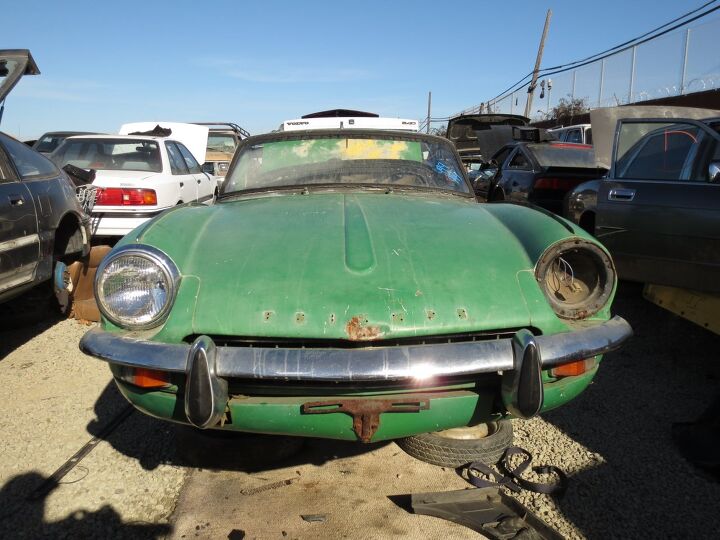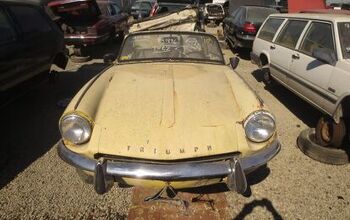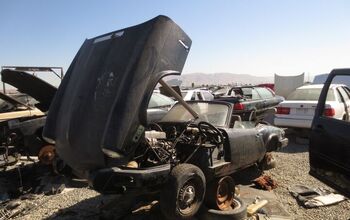Junkyard Find: 1967 Triumph Spitfire Mark III

Some old cars have managed to maintain a steady trickle of fresh examples into self-serve wrecking yards since I began crawling around in such yards, back in 1981 or so. The kings of this phenomenon are, of course, the Fiat 124 Sport Spider (in a few years of this series we’ve seen this ’71, this ’73, this ’75, this ’78, and this ’80), and the MGB (so far, this ’67, this ’71, this ’75, this ’79, and this ’79 with Toyota 20R power). The MGB’s British Leyland cousin, the Triumph Spitfire, has been a rarer but just-as-steady find for me; first this ’65 and then this ’75, and the prehistory of this series gives us this Spitfire-sibling ’67 GT6 as well. What these cars have in common is near-scrap value when in rough shape, respectable price tags when in nice condition, and a tendency to be hoarded by guys who plan— someday— to turn the former condition into the latter condition. Eventually, reality sets in and a car that sat in a driveway from the time of the Chowchilla Kidnapping until a few months ago takes its final trip. Here’s a rust-free, fairly complete, restorable early-ish Spitfire that I saw last month in a Northern California yard.
Every time I write about a junked car like this, readers proclaim that the chrome pre-5MPH-crash-rule bumpers must be worth tremendous sums. However, these yards are prowled seven days a week by guys who make their livings buying parts that are worth much more than the flat-rate price charged by big junkyard chains (e.g., BMW E30 limited-slip differentials, Lexus Nakamichi amplifiers), and they never buy these bumpers. An overdrive transmission from an MGB or Spitfire is another story; that will be gone within two days of the car hitting the yard.
Likewise, Jaeger and Smiths gauges aren’t worth a whole bunch (though some VDO gauges— and I ain’t saying which ones— are always worth grabbing).
The Mark III got the new-for-1967 1296cc pushrod four, making an optimistically rated 75 horsepower. A junkyard shopper wanted the SU carbs, but the engine is doomed to the shredder and subsequent trip to China via the Port of Oakland.
These cars are fun to drive, they look cool, and they make fine projects thanks to the abundance of cheap used parts. Someday, though, the flow of those parts will dry up… and then we’ll all be sorry that we didn’t buy pre-Malaise Spitfires when they were cheap.

Murilee Martin is the pen name of Phil Greden, a writer who has lived in Minnesota, California, Georgia and (now) Colorado. He has toiled at copywriting, technical writing, junkmail writing, fiction writing and now automotive writing. He has owned many terrible vehicles and some good ones. He spends a great deal of time in self-service junkyards. These days, he writes for publications including Autoweek, Autoblog, Hagerty, The Truth About Cars and Capital One.
More by Murilee Martin
Latest Car Reviews
Read moreLatest Product Reviews
Read moreRecent Comments
- MaintenanceCosts This is probably as good as B5.5's get, but keeping it that way is going to be very very expensive, and for all that money you won't even have three pedals.
- Urlik Peak Passat.
- Cla65786503 Do the esses at Riverside International Raceway count as a corner?
- El scotto Do the Agnellis care about any of this?
- El scotto Wait! What are these higher-level Kias you write about?











































Comments
Join the conversation
As Spitfires go, (and, granted, most of them don't), this is actually a pretty collectable year/model, worth saving, even if only for the parts. The 1296cc engine was a short stroke, better revving version, compared to the later 1500cc version. Many racers choose this engine. The bumpers and various bits and pieces of this year are hard to find, and this body looks straight and relatively rust-free when compared to the ones we find on Craigslist here in the East. Spitfire restorations require a higher degree of optimism than most other British cars, but they are a fun drive for folks who acquire the taste.
I recently purchased a 1969 Spitfire and have been looking for parts. I l live in Northern Ca. Can I ask what yard this was in?